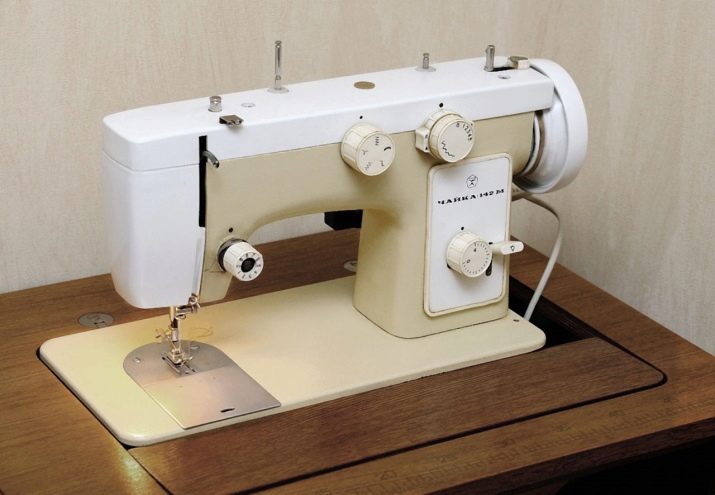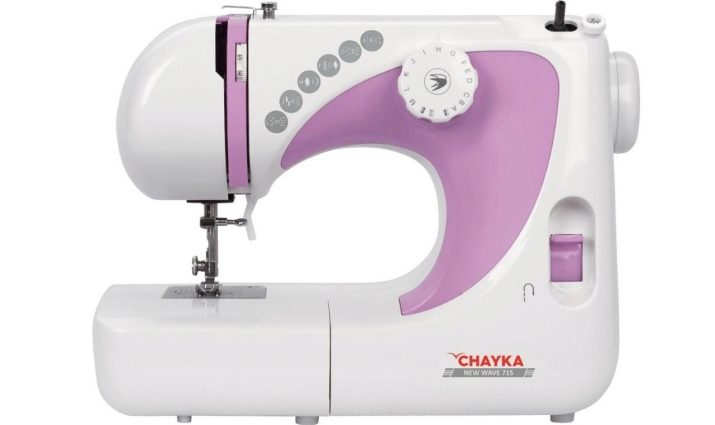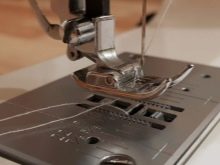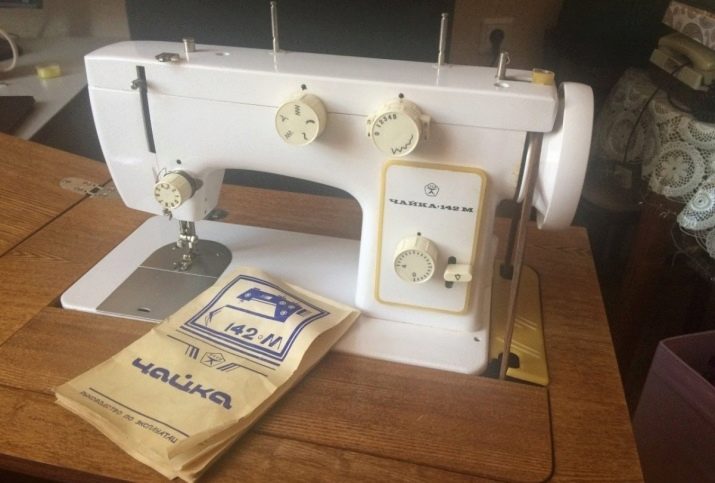Sewing machines "Chaika": description, types and instructions for use

There is a wide variety of sewing machines on the market today. Moreover, they differ not only in functionality, but also in appearance, manufacturer and some other characteristics.

The Chaika brand is considered a popular domestic manufacturer of sewing machines. It has a rather long history of existence, and therefore has already managed to win the love and trust of consumers. (and not only in our country, but abroad).
What are the features of Chaika devices? How to set up and adjust the clipper correctly? What problems can arise during the operation of the device? What are the best models? You will find answers to these and some other questions in our article.

Brand info
Chayka sewing machines have a rather long and interesting history. So, the factory in which they began to be produced was established in 1900... At that time, the production of units was carried out using the latest technologies and scientific developments.
Thus, we can conclude that the Chayka brand is quite old and time-tested.

The large-scale production of sewing machines under the Chayka brand began in 1914. At that time, the plant produced more than 600,000 units per year. This number was due to the great demand for devices: cars were popular not only among domestic consumers, but also abroad (for example, in Japan and China).

After the October Revolution, there was a decline in the production of sewing devices. but after the Great Patriotic War in the USSR, the demand for cars increased again, accordingly, their production has intensified.
Generally speaking, the sewing machine received its name - "Seagull" for a reason. The device was named after the first Soviet female cosmonaut to have a similar call sign.

The peak of production of sewing machines "Chaika" fell on the 90s of the twentieth century. Despite the fact that during this period a large amount of equipment was imported to our country from abroad, many domestic needlewomen still preferred Soviet products.

Today sewing machines of the Chayka brand are widely represented in the domestic market... As at the very beginning of their production, only experienced professionals are engaged in the manufacture of devices, who in their work rely on the latest developments and technologies.
In addition, the manufacturer offers customers a fairly wide range of products - accordingly, each needlewoman will find a device to her liking.
It is also planned to expand the product lines: in the future, in addition to machines, other devices (in particular, ironing boards) will be produced under the brand name.

Features of devices
Among the main features of the devices of the firm "Chaika" it is customary to highlight the following characteristics:
- quality;
- reliability;
- durability;
- ease of use;
- modern design.

All parts of sewing machines "Chaika" (pedal, electric drive, paws, etc.) are made of high quality materials with a long service life.
At the same time, despite the rather complex internal structure, the machine is quite easy to use even for beginners, and in case of any questions, each user should familiarize himself with the operating instructions.
At the same time, it is worth noting the fact that regardless of the fact that the brand itself is quite old, it observes all modern trends. That's why the unit of the company "Chaika" will correspond to all the latest developments, not only in terms of the functional component, but also in appearance.

Besides, Of particular interest is the fact that today on the market you can find both old models of devices and newer and more modern ones... The thing is that even despite the fact that the functionally and technically old models (for example, 132 and 134) are already outdated, they are still capable of working. This is possible due to the responsible approach of the manufacturer to its product.

On the other side, if you are looking for a modern machine that meets all the requirements and is made taking into account the latest developments, then you should pay attention to the latest models of "Chaika"... Such machines not only have a wide range of useful functions, but also have an aesthetically pleasing appearance.

The lineup
The assortment of sewing machines of the "Chaika" company includes various models of devices. Here you can find electric, hand, foot and other units. Today in our material we will consider the most common of them.
"Chaika 134"
"Chaika 134" is a model of a sewing machine, which in terms of its functional, technical and external characteristics is similar to the 132 version. With this unit, you can make straight and zigzag lines. In addition, there is a reverse motion.

"Chaika 143"
The machine is intended solely for domestic use. It can be used to process linen, synthetics, silk, etc. For this, there are several lines provided. Stitch length and width are adjustable. During operation of the machine, you can use sewing cotton and natural silk threads.

Chaika 143 is available in several delivery options:
- in a table with a foot drive;
- on a stand and in a case with an electric drive;
- with an electric drive and a foot drive in the table;
- with an electric drive in the table;
- with a manual drive on a stand and in a case;
- with a manual drive in the table.
In addition to the main device, the kit includes a set of sewing accessories in a box, instructions for use, and a warranty card.



"Chaika 132M"
This device is the first electromechanical sewing machine from the Chaika manufacturer. The model was in production from 1980 to 1992.
It is believed that Chaika 132M can handle a wide variety of fabrics (including thick fur).
As for the technical characteristics of the device, it is important to note that the manufacturer has provided 4 types of stitching and 23 sewing operations. The maximum stitch length and width are 4 and 5 mm, respectively.
The device has a rather impressive weight - 13.5 kg. That is why it is quite difficult to deal with it (especially with regard to its transportation).

"Chaika 134A"
This model belongs to the category of electromechanical machines. Moreover, it is well suited for home use, and even a novice needlewoman can handle it.
The outer casing of the machine is made in white with small splashes of color. The device panel contains the step-by-step diagrams needed to get started. For your convenience, the manufacturer has also provided a "Reverse" button, by clicking on which, you can fasten at the end of the line or cut the thread.

"Chaika 134A" is programmed to perform 10 sewing operations (including zigzag, straight line, semiautomatic buttonhole, etc.). At the same time, there is a function of adjusting the length and width of the stitch.
The device was manufactured in Vietnam. The machine weighs about 6 kilograms.

The models described above are older versions of the Seagull. Today there are more modern and advanced models with improved functions and attractive appearance. These include models 110, 210, 325A, 715, 735, etc.
Setting and adjusting
- First of all, set the thread take-up to its highest position. This procedure can be carried out by means of a flywheel.
- Then raise the foot.
- Now you need to insert the needle into the needle holder. Make sure it is secured all the way.
- At this point in the adjustment, it is necessary to pull out the spool pin and reinforce the spool of thread.
- Next, you should thread the thread. Moreover, refueling should take place in a strictly defined sequence. So, first this needs to be done from a bobbin or spool through a thread guide. After that, between the washers of the regulator, you need to check the thread tension. Next, thread the thread into the thread guide on the machine head and into the thread guide on the needle holder. Next, we thread the thread into the eye of the needle.
- The next step is to open the slide plate.
- We take out the bobbin case and remove the bobbin itself.
- Loosen the friction screw and wind a few screws around the bobbin. Next, we install it on the reel spindle and press it down. We wind up the bobbin and insert it into the cap.
- Now we thread the thread into the slot and under the tension spring.
- Insert the bobbin case onto the shuttle shaft and tighten the friction screw.
- Now you can lower the needle and raise it to the top position. This action is carried out by means of a flywheel. As a result, you should grab the shuttle thread.
- We remove the shuttle thread and thread both threads under the foot.
- Depending on the material with which you will be working, we select the appropriate mode.
Thus, after completing the setup and adjustment, your machine is ready for full-fledged work.





Operating rules
Before starting to work directly with the device, it is important to carefully study all the rules for its operation. For this it is necessary to read the manufacturer's instructions, which are an integral part of the standard set of any model of the sewing machine "Chaika".

It should be noted right away that the application manual is divided into several sections, each of which is devoted to a different topic and explains how to use the device correctly in a particular case.
First of all, you need to pay attention to the declared safety requirements.
Before turning on the machine, you should make sure its external integrity (especially for wires and power plugs).

In the General Requirements section, you will find guidelines for installing the needle and handwheel. It also noted the need for regular lubrication: you need to lubricate the machine with a specially designed oil (for example, you can use I-20A GOST 20799-88).

The operating instructions also include the following sections:
- "Purpose of the machine" - the device is allowed to be used only in those cases and for those purposes that were originally provided by the manufacturer;
- "Technical details" - all technical indicators of the device are described in detail here;
- "Contents of delivery" - during the purchase process, it is important to check the presence of all the elements specified in this paragraph;
- "Recommendations for a quality stitching" - the section describes the features of working with the device (this section will be especially useful for beginners);
- "Control elements and components of the machine" - this chapter usually contains an illustrative block diagram;
- "Set of accessories" with pictures;
- "Types of operations performed" with diagrams and brief explanations;
- "Preparing to work with the foot control" with short but capacious instructions;
- "Preparing the machine for work" - the section describes actions that are mandatory;
- "Preparing the machine for sewing" - a section with subsections and explanatory diagrams;
- "Machine lubrication" - describes in detail the rules of lubrication;
- "Cleaning the shuttle" - the section includes the rules for servicing the machine;
- "Possible malfunctions and methods of their elimination" - the chapter will be useful in case of breakdowns.

Thus, the manufacturer provides the user with rather detailed operating instructions, the rules and principles of which should be strictly observed. If you have any questions or difficulties, you can also contact the sales assistant in the store.
It is important to keep in mind that some points of the instructions may differ depending on the specific model of the device.

Major malfunctions and their elimination
Despite the fact that sewing machines "Chaika" are quite reliable devices made of high quality materials and designed for long-term use, the manufacturer does not exclude the occurrence of malfunctions and breakdowns.

Possible malfunctions and methods of their elimination are described in the operating instructions for the device. Let's consider the main ones.
Broken needle
Most often, this problem occurs due to the wrong position of the presser foot, the wrong choice of a specific needle (or if the needle itself is of poor quality), as well as in cases when a beginner is working with a sewing machine.
It is quite simple to fix this problem, and the method of elimination itself will depend on the cause of the breakdown.
So, the manufacturer recommends changing the needle to a more suitable one, or checking the head screw of the presser foot (it must be fixed in such a way that the presser foot is in the correct position relative to the needle).

Upper thread breaks
If this problem occurs, the first step is to make sure that you have threaded the correct thread. In the process of performing this action, you must carefully follow the instructions. Also, rupture can occur due to the fact that the thread is too tight (in this case, the tension must be loosened). Another reason is the poor quality of the thread or the needle itself.

Bobbin thread breaks
Most often the bobbin thread breaks due to the fact that it was originally threaded incorrectly in the bobbin case.

Skip stitches
This malfunction is one of the most common. It occurs due to the use of polished threads, an incorrectly installed or unsuitable needle. If these problems are eliminated, then the sewing process will take place according to all the rules.

Difficulty moving the material
In this case, you need to check the lift of the teeth and the clamping of the material. Most likely, the reason lies in this.
To fix the problem, it is recommended to adjust the tine lift, unscrew the screws, remove the cover and turn the presser bar screw clockwise.

Hard move
If you notice that the sewing machine is working with a lot of resistance, then you should clean the shuttle course of fluff and loose thread, lubricate the machine with oil, clean the area under the needle plate, or stretch the belt.

In addition to the problems described above, problems such as knocking footpegs, belt slippage, or no lighting may occur. They are quite rare, however, if they occur, it is important to carefully study the instructions for use.
Anyway, in no case should you neglect the repair of the sewing machine (especially if it sews the other way around or the parts have become unusable)... If you have enough technical knowledge, as well as in the case of strict adherence to the instructions, repair work can be carried out independently. In other cases, it is recommended to consult a specialist.

The desire of the manufacturer to grow, develop and constantly improve the quality of its products has led to the fact that sewing machines "Chaika" still remain competitive and are in demand in the market.

The description and functionality of the new 750 model of the Chaika sewing machine can be found in the following video.









My sewing machine CHAYKA-2 was bought in 1974 and I still sew on it. Only instead of a mechanical drive I installed an electric one. I want to buy a new and only CHAYKA - a reliable machine. I think that now the quality will be the same as that of the old model.
In vain. Take better of the old model, for example, Chaika 142.